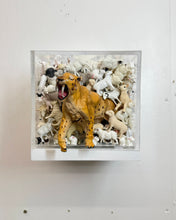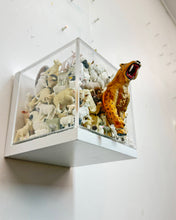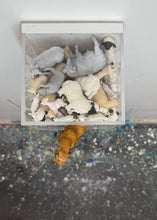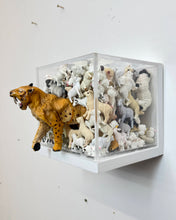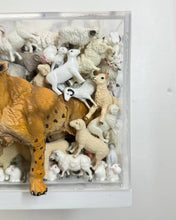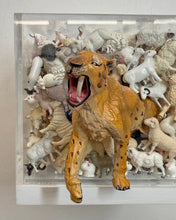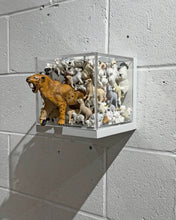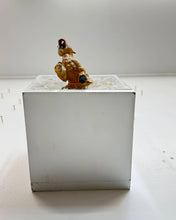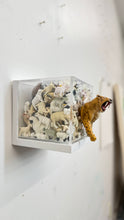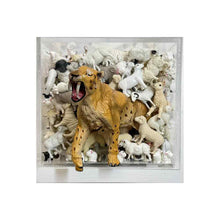
7” x 7” x 7”
Toy sheep and tiger enclosed in plexiglass and wood
2025
In a world increasingly shaped by authoritarian rule and performative power, No Room To Breathe challenges dominant narratives of strength and leadership through the use of 100+ miniature toy plastic sheep and a solitary saber-toothed tiger to reimagine the flock not as passive followers, but as a potent symbol of the silenced majority. In this case, the masses are deemed disposable, mindless, or weak even though they take up more space and hold greater population.
The tiger - bold, isolated, and commanding - represents the illusion of singular power. In many societies, one figure presides over millions, weaponizing fear, surveillance, or charisma to maintain control. Yet this figure is outnumbered. Outmatched. And in truth, profoundly alone...but deemed entirely powerful.
The sheep, often dismissed as conformists, embody collective resilience. Their unity, mutual reliance, and quiet presence confront the viewer with a deeper, dystopian truth: that real power lies in solidarity, not in community. This sculpture invites viewers to reflect on how protest can be stifled not by lack of numbers, but by a culture that glorifies the predator and ridicules the herd.
The transparent box represents a sense of limited freedom. The sheep, aka the majority, are free to "see" all that's going on around them; they can even see the tiger who's half-in their world, half-out, suggesting a false sense of relatability while truly, the only character who can breathe freely without confinement is the tiger, although parts of him appear to reside in confinement in order to gain trust of the masses who cannot leave the boundaries of the box they're in, but mistake him for being "one of them".
Whether the viewer identifies with being the tiger or the sheep in this scenario is likely to be a result of one's socioeconomic situation.
In Western culture, we're prone to glorify the predator (aka the "leader", the celebrity, the politician, the boss... the person in the power position) and ridicule the herd (aka the "masses", the consumers, the workers, the lower and middle class population). This misidentification of communities can lead to a dangerous mistaking of dominance as leadership and positive change is threatened when a predator is glorfied and the herd is ridiculed.
To further the discussion of what communities are being represented by the sheep in this analogy, here's a short list of some groups that hold a populated majority but function/exist within the limitations of a marginalized, situational minority:
-
Women: Majority of the world, yet vastly underrepresented in power structures.
-
Black South Africans under apartheid: 80% of the population, governed by the white minority.
-
Indigenous peoples in the Americas: Majorities prior to colonization, decimated and politically erased.
-
The Working Class: The backbone of industry, but left out of boardrooms and policy decisions.
-
Youth in authoritarian states: Countless in number, but locked out of their own futures.
In a society that feels more divisive than ever before, more disconnected despite increased opportunities to stay connected via technology, No Room Breathe is challenges the viewer to reflect on power dynamics - who truly holds the power?; can power dynamics be shifted?; do any people come to mind who may have been sheep who later became tigers?; are there any people in positions of leadership who seem to have the well-being of the sheep in mind or is everyone in this position feigning a false sense of camaraderie?
As always, the artist admits she asks a lot of questions, but doesn't have the answers.
*This piece was created for the Easy Tiger group show in Hamilton at BSide Gallery - you can watch the "making of" video of this piece here. Due to unfortunate events on opening night, this sculpture was knocked off the wall and broke...the sheep could not be contained...as a result, it's since been reworked into Power of the Herd.
Continued thanks to curators Laura Heaney and Jill Letten for the invitation to participate in this show.











